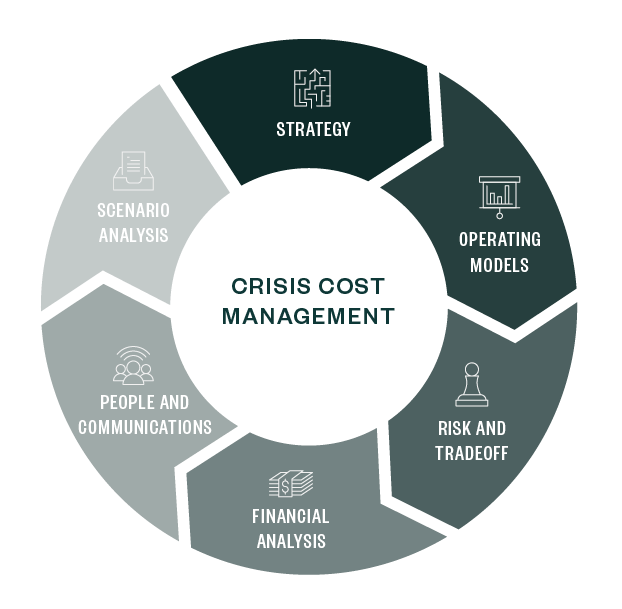 COVID-19 is challenging many companies to take quick action to reduce financial losses by sustaining revenue, retaining customers, and drastically reducing costs.
COVID-19 is challenging many companies to take quick action to reduce financial losses by sustaining revenue, retaining customers, and drastically reducing costs.
As demonstrated in previous recessions, executives can be tempted to cut from their largest spend categories, often their workforce, to preserve margins. While layoffs are sometimes necessary, they can be harmful to the business, affect morale, and slowdown productivity at a time when companies need to be at peak performance. More importantly, short-term cost reductions could come at the expense of future growth.
Disruptive times can lead to uncertainty, which creates the need for experimentation in the form of operating model changes, operational improvements, and aggressive adjustments to product and service offerings.
Using a crisis cost management analysis to evaluate your business’s operating model and cost structures could help remediate near-term issues and position your company for a quicker recovery. As with any business transformation, emerging successfully requires a strategic roadmap that outlines the priorities to defer, eliminate, or reduce costs.
Below, we explore how this structured approach could help your company uncover competitive advantages and deliver more value at lower costs.
The Importance of Loyalty
Before starting a crisis cost management analysis, there’s an important consideration related to your customers and staff—loyalty.
Customers
When seeking cost reduction opportunities, businesses tend to stop investing in customer-centric projects or reduce support teams without considering the long-term impact on the customer experience.
Empathizing with your customers during this unprecedented time could draw you closer and make your customers feel more valued and supported. Working together can help you learn what they truly value and provide insight into how to invest in an elevated customer experience.
Employees
There’s no playbook to navigate a period like the COVID-19 pandemic, but the tone set by your management team and their ability to communicate objectives, targets, and decisions is key to engaging employees.
By gathering input from employees at all levels, they can help you identify and work through solutions. In turn, you’ll solidify their trust in a way that could help build an agile and adaptive culture that helps create a competitive edge.
Crisis Cost Management Framework
COVID-19 is forcing everyone to reassess their business strategy, operating model, and cost to serve archetypes.
By combining a risk-reward approach with a zero-based budget methodology, which encourages you to start from zero and justify your budgets each year, you could uncover strategic possibilities that:
- Address short-term challenges
- Improve margins
- Reduce risk
- Enhance productivity
- Provide insight into how your company could emerge from downturn in a better position
Challenging the way your company thinks about its operating model and reimaging its performance could unlock productivity breakthroughs.
A crisis cost management analysis focuses on the six key imperatives to successfully navigate disruption.

1. Strategy
Defining your new business strategy during disruption is crucial. Every element where you compete, in terms of geography, product, customer and product segments, and value proposition needs to be validated and adjusted to set the course to a sustainable outcome. Define your strategy with the following actions:
- Complete high-level customer profitability analyses
- Adjust product mix and service portfolio
- Develop a prioritized recovery plan to exit the downturn successfully
- Create a two-year financial forecast and assess need to revise pricing strategy
2. Operating Models
Though it may seem counterintuitive, now may be an appropriate time to pursue talent or distressed assets to position the company for a quicker return with strategic expertise and enhanced capabilities. Steps and methods to adjust your operating models can include the following:
- Assess options to defer investments in new facilities
- Identify opportunities to create shared service functions
- Adjust operating model for a revised go-to-market strategy
- Understand cost-to-serve models for all customer segments
- Unlock technology platforms that can reduce complexity and cost to serve
3. Risk and Tradeoff
As you identify potential opportunity areas during this period, it’s important to also assess the risk they present. This can be done through the following actions:
- Establish cost baseline and profit margins that sustain the business
- Set criteria to assess risk appetite and sensitivity analysis for downside scenarios
- Establish framework to compare risk against opportunity costs
- Evaluate M&A as a strategic alternative to gain market share
4. Scenario Analysis
With uncertainty ahead, it’s important to envision how implemented strategies could play out. To perform a scenario analysis, your company could consider the following:
- Assess production reorganization
- Assess risks to ensure continuity of supply
- Estimate supply chain restructuring impacts
- Determine back-office consolidation options
- Evaluate technology and process improvements
5. Financial Analysis
Understanding the profitability of your different customers, channels, and markets may uncover costs that could be eliminated immediately. This could be an opportune time to double down on core and profitable products. These analyses can be done through the following:
- Develop cost structure for new operating model
- Assess working capital, cash management, and asset utilization
- Reduce discretionary expenses such as travel, bonuses, and hiring
- Prepare zero-based budgets and assess options for variable cost models
6. People and Communications
To implement new business structures and models, you’ll want to make sure employees are aware of what actions and responsibilities are expected of them. Empower your workforce to contribute to solutions ideas through the following actions:
- Enable business continuity, including implementing work-from-home set-ups, and establish communication channels
- Assess viability for self-funded benefit plans, hour reductions, furloughs, and performance pay
- Determine options for short-term outsourcing arrangements
- Develop internal and external communication plans
We’re Here to Help
To learn more about how a crisis cost management could help your business navigate COVID-19 disruption and prepare for the future, contact your Moss Adams professional.
For additional insight on assessing your business costs and seeking appropriate capital solutions, read our articles on business recovery plans for short-term needs and recapitalization plans for longer-term needs.